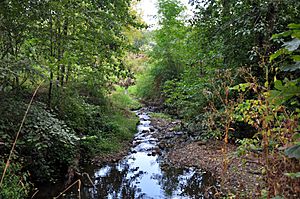Stephens Creek (Oregon) facts for kids
Quick facts for kids Stephens Creek |
|
|---|---|

Stephens Creek near Butterfly Park
|
|
|
Location of the mouth of Stephens Creek in Oregon
|
|
| Country | United States |
| State | Oregon |
| County | Multnomah |
| Physical characteristics | |
| Main source | Tualatin Mountains (West Hills) Portland, Oregon 467 ft (142 m) 45°28′29″N 122°42′03″W / 45.47472°N 122.70083°W |
| River mouth | Willamette River Portland, Oregon 11 ft (3.4 m) 45°28′08″N 122°40′06″W / 45.46889°N 122.66833°W |
| Length | 2 mi (3.2 km) |
| Basin features | |
| Basin size | 1.2 sq mi (3.1 km2) |
Stephens Creek is a small stream, about 2 mi (3.2 km) long. It flows entirely within the city of Portland in the U.S. state of Oregon. A stream like this that flows into a larger river is called a tributary. Stephens Creek flows into the Willamette River.
The creek starts in the Hillsdale neighborhood. It then travels east through areas with homes and businesses. You can also see patches of forest and parkland along its path. It eventually joins the Willamette River just north of the Sellwood Bridge.
Exploring Stephens Creek's Path
Stephens Creek flows under Interstate 5, a major highway. It also goes down a canyon that follows Southwest Taylors Ferry Road. The creek finally meets the Willamette River at Willamette Moorage Park.
This park is part of a larger group of natural areas. These areas cover about 35-acre (14 ha) and are called the South Portland Riverbank. Other cool places in this group include Butterfly Park and Willamette Park. These spots offer great places to explore nature in the city.
Nature and Wildlife Along the Creek
Stephens Creek Nature Park is a protected area near where the creek begins. It's about 3.38-acre (1.37 ha) in size. This park gives animals and plants a safe home in the middle of the city. It also provides open space for people to enjoy.
Downstream, near where the creek meets the Willamette River, there's important work happening. Experts are working to improve the creek's habitat for fish. This helps endangered fish species, like Chinook salmon, that use the creek.
Protecting the Creek: Green Streets Project
A special project called "Green Streets" helped improve the creek's headwaters in 2007. The headwaters are where a stream begins. This project used a smart idea called bioswales.
Bioswales are like special ditches along the side of the street. They are designed to collect rainwater that runs off roads. Rocks and native plants in the bioswales help slow the water down. This allows the water to soak into the ground. It also cleans the water, removing pollution before it reaches the creek. This helps keep the creek's water flow steady and clean. This project was a team effort between local neighbors and the City of Portland.


